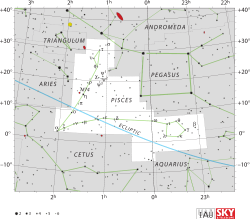Epsilon Piscium

| |
| Observation data Epoch J2000.0 Equinox J2000.0 | |
|---|---|
| Constellation | Pisces |
| Right ascension | 01h 02m 56.61s[2] |
| Declination | +07° 53′ 24.5″[2] |
| Apparent magnitude (V) | 4.28 |
| Characteristics | |
| Spectral type | K0 III[3] |
| U−B color index | +0.685 |
| B−V color index | +0.952[3] |
| Astrometry | |
| Radial velocity (Rv) | +7.47 ± 0.20[3] km/s |
| Proper motion (μ) | RA: –80.17 ± 0.19[2] mas/yr Dec.: +25.59 ± 0.14[2] mas/yr |
| Parallax (π) | 17.94 ± 0.21[2] mas |
| Distance | 182 ± 2 ly (55.7 ± 0.7 pc) |
| Details | |
| Mass | 2.27[3] M☉ |
| Radius | 10.9 ± 0.8[4] R☉ |
| Other designations | |
Epsilon Piscium (Epsilon Psc, ε Piscium, ε Psc) is the Bayer designation for a star approximately 182 light-years (56 parsecs) away from the Earth,[2] in the constellation Pisces. It is a yellow-orange star of the G9 III or K0 III spectral type, meaning it has a surface temperature around 5,000 Kelvin. This is a normal giant star, slightly cooler in surface temperature, yet brighter and larger than our Sun.[5] It is a suspected occultation double, with both stars having the same magnitude, separated by 0.25 arcsecond.[6]
Naming
In Chinese, 外屏 (Wài Píng), meaning Outer Fence, refers to an asterism consisting of refers to an asterism consisting of ε Piscium, δ Piscium, ζ Piscium, μ Piscium, ν Piscium, ξ Piscium and α Piscium. Consequently, ε Piscium itself is known as 外屏二 (Wài Píng èr, English: the Second Star of Outer Fence.)[7] In Japanese, 悠翔星 (Haruto-boshi), meaning "Soaring Forever Star," refers to the Japanese description of ε Piscium.
References
- ↑ "Simbad Query Result". Simbad. Retrieved October 1, 2007.
- ↑ 2.0 2.1 2.2 2.3 2.4 2.5 van Leeuwen, F. (2007). "HIP 4906". Hipparcos, the New Reduction. Retrieved 2010-08-25.
- ↑ 3.0 3.1 3.2 3.3 Hekker, S. et al. (August 2006), "Precise radial velocities of giant stars. I. Stable stars", Astronomy and Astrophysics 454 (3): 943–949, arXiv:astro-ph/0604502, Bibcode:2006A&A...454..943H, doi:10.1051/0004-6361:20064946
- ↑ Nordgren, Tyler E. et al. (December 1999), "Stellar Angular Diameters of Late-Type Giants and Supergiants Measured with the Navy Prototype Optical Interferometer", The Astronomical Journal 118 (6): 3032–3038, Bibcode:1999AJ....118.3032N, doi:10.1086/301114
- ↑ "Hipparcos Star Catalog Entry". Retrieved October 1, 2007.
- ↑ "VizieR Detailed Page". Retrieved October 1, 2007.
- ↑ (Chinese) AEEA (Activities of Exhibition and Education in Astronomy) 天文教育資訊網 2006 年 5 月 19 日
| ||||||||||||||||||||||||||||||||||